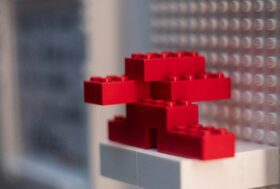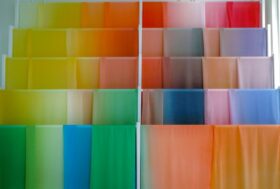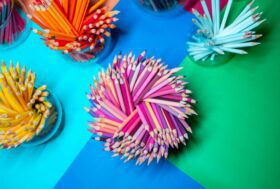Reflections on a flipping good journey

I am very fortunate to have worked in two schools that promote and celebrate teacher development. As I attended a university in which exercises prior to laboratory sessions (‘pre-labs’) were part of the course, I wondered whether this model could be applied to my Year 9 chemistry class. I made a video on how to set up a certain piece of apparatus (distillation), asked my class to watch it for homework, and then got them to replicate it in the classroom. The results were uniformly amazing, with one lesson observer saying that it was as good as their sixth-form class. I subsequently learnt that this is formally known as ‘flipped learning’ (Bergmann & Sams, 2012). The Flipped Learning Network has published the following definition in response to misinterpretations and misconceptions of what flipped learning is (Flipped Learning Network, 2014):
Flipped Learning is a pedagogical approach in which direct instructionA method of instruction in which concepts or skills are taught using explicit teaching techniques, such as demonstrations or lectures, and are practised until fully understood by each student moves from the group learning space to the individual learning space, and the resulting group space is transformed into a dynamic, interactive learning environment where the educator guides students as they apply concepts and engage creatively in the subject matter.
I decided to sign up for an MEd (University of Cambridge) with the aim of determining whether videos created by individual teachers elicited better attainment in class than videos created by an unknown author. The general conclusion from my research was that it was the judicious choice of video that mattered based on content, rather than who created the video. I have continued to pursue flipped learning as a useful technique and have completed a couple of online courses run by the Flipped Learning Global Initiative.
Recognising the barriers
I had to overcome my own misconceptions with regards to learning something new and using digital technology in the classroom. I began to wonder whether the same obstacles existed for my colleagues and how to go about breaking down these barriers. When preparing a presentation about flipped learning, as part of our school CPD programme,I learned that tackling misconceptions, demystifying theory and achieving teacher buy-in, are key in successfully implementing the use of digital technologies in a school.
As teachers, we all know how hard it is to identify and correct misconceptions, and flipped learning is no different. Many people worry that they lack experience using something ‘digital’, and just telling them that ‘it will be fine’ won’t change their minds. Equally, there is a perception that flipped learning is all about making a video and getting the pupils to watch it. Often, these two issues (i.e., the fear of digital learning and a lack of understanding of what it entails) go hand-in-hand. As a result, teachers often believe that they don’t have the necessary skills to make a video, and since they assume the video is the point of flipped learning, they dismiss even attempting it.
Challenging misconceptions
Flipped learning is not all about videos. The flipped model is about changing how you use the individual space (i.e. homework) versus the group space (i.e. class work) and recognising where you can be of most benefit to all pupils. Making this mental switch can be hard because we often think of new topics as being difficult to learn.
However, according to Bloom’s Taxonomy (1956) the tasks of remembering and understanding are thought to be of lower-order thinking than say the tasks of applying, analysing and evaluating. Thus, the introduction of a new topic will normally involve relatively low order thinking. Do you really need to use valuable lesson time to perform low order tasks? Sometimes the answer is yes, but often the lower order concepts could be introduced prior to the lesson. This does not mean that every teacher is required to make a video, only that they choose wisely from pre-existing ones. This then frees up valuable class time to facilitate movement to higher-order thinking and potentially deeper learning. To use my earlier example, my pupils performed a low order task (learning names of equipment and how they fit together) as part of their homework, which prepared them for a future lesson where I asked them to apply their knowledge by physically constructing the apparatus without any in-class guidance necessary.
One of the barriers is that teachers can feel intimidated by the wide-range of technology available. Most people will need guidance at this point, and in the context of my school we have set up a ‘Staff Digital Learning Group’. This group comprises like-minded colleagues who are willing to help others as and when required, to periodically disseminate best practices, and to highlight digital hints and tips.
Perseverance and pragmatism
Changing how we work, breaking habits and learning something new is hard; it takes a lot of time and effort to achieve, and this is not limited to our pupils. Therefore, we have to feel that the effort we are putting in is going to be of value to both us, as teachers, and to the pupils in our lessons. Finding, developing or creating the materials that pupils will use independently does take time, but this is balanced by the better quality of interaction you will gain in class. As a starting point, choose one lesson, or small topic to flip, but rather than create your own video, why not find one that meets your requirements to use as a benchmark? Remember, the most important thing is that you do something with it in your lesson. No video can replace you and your expertise.
Recognising these challenges has resulted in our school introducing a more consistent approach in helping to overcome these issues. We now offer departmental INSET drop-ins, whole-school INSET and break-time digital learning sessions, all of which have generated a greater level of conversation between colleagues, helping to demystify theory and to tackle misconceptions through collaboration.
Any form of intervention or new teaching style in the classroom should be preceded by the question ‘will my pupils benefit from this?’ There is a plethora of research articles that highlight one intervention or another, based on this trial or that, with this number or subsection of pupils or in that number of schools, but only you will know the pupils that are presented in front of you in your classroom. To this extent, relationships matter, because only through developing these relationships with your pupils can you truly understand their needs in the classroom, and predict how they will respond to the introduction of new and varied techniques.
References
Bergmann J and Sams A (2012) Flip your classroom: Reach every student in every class every day. Arlington, VA, USA: International Society for Technology in Education.
Bloom BS (1956) Taxonomy of educational objectives: The classification of educational goals. Harlow, England: Longman Group.
Flipped Learning Network (2014). Definition of flipped learning. Available at: http://www.flippedlearning.org/domain/46(accessed 17 December 2015).
This article was published in January 2019 and reflects the terminology and understanding of research and evidence in use at the time. Some terms and conclusions may no longer align with current standards. We encourage readers to approach the content with an understanding of this context.










